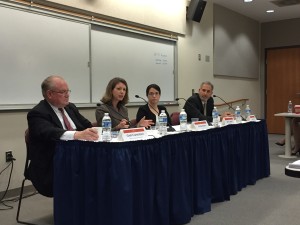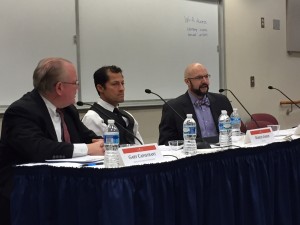On November 19, the Health Law and Policy Brief hosted its fall symposium “Telemedicine: Regulatory Framework & Barriers to Expansion.” Telemedicine emerged over 40 years ago and is a rapidly expanding area of healthcare in the United States. The panelists at the symposium discussed the current state of Telemedicine, its regulatory framework, and the barriers to its expansion. Mr. Gary Capistrant, the Chief Policy Advisor to the Telemedicine Association, moderated the panels.
The first panel focused on barriers to the expansion of telemedicine. The speakers on the panel were 1) Ms. Alexis Gilroy, Partner at Jones Day; 2) Ms. Amy F. Lerman, Senior Counsel at Epstein Becker Green; and 3) Mr. Jeffrey Mitchell, Of Counsel at Lukas Nace Gutierrez & Sachs LLP.
These three speakers brought up and discussed several important barriers that need to be addressed for telemedicine to reach its full potential. Ms. Alexis Gilroy emphasized that regulation of telemedicine is state by state. Regulators are dealing with a huge number of rules that vary, and there is yet another layer of regulation once telemedicine moves outside of the United States. In some ways, regulators can supervise telemedicine more directly, but varying rules complicate that. A potential solution is to create a federal system of regulation, but that would take away power from states, which raises another host of issues. Ms. Amy Lerman focused on barriers regarding payment. The question from all telemedicine clients is how they are going to get paid. The various state regulatory regimes also have varying reimbursement schemes, which seriously hinder telemedicine, which cannot move forward if they are not paid. Finally, Mr. Jeffrey Mitchell questioned the idea of “universal service.” While technology has made magnificent advances in the last two decades, there is still the problem of affordable access to phones and the Internet in rural areas, which are usually in greater need of telemedicine. Even if rural areas do have access to phones and the Internet, connectivity is constantly an issue. A solution is to subsidize rural phones by overcharging urban businesses, however that comes with its own problems that have yet to be adequately addressed.
The second panel focused on how the federal government regulates mHealth devices. The speakers on this panel were 1) Mr. Daniel Gottlieb, Associate at Epstein Becker Green; and 2) Mr. Robert Jarrin, Senior Director of Government Affairs at Qualcomm.
Both of these speakers built upon the comments of the speakers on the first panel and further elucidated how involved the government is in regulating telemedicine. Mr. Daniel Gottlieb described the various ways that the federal government regulates mHealth devices. Mr. Gottlieb began by applauding telemedicine saying that clinical data obtained through its programs has immense potential to spur medical advances. He explained that clinical and IT personnel collaborate in telemedicine programs. The Department of Health and Human Services (HHS), the Food and Drug Administration (FDA), and the Federal Communications Commission (FCC) then regulate their efforts. If certain programs work with patients in the European Union (EU), they then also must comply with the EU Data Privacy Directive. His points echoed those of Ms. Gilroy. While careful regulation is necessary for safety purposes, Mr. Gottlieb emphasized a need to streamline the regulation of telemedicine. Mr. Jarrin’s points reiterated the fact that there are several regulatory bodies involved in telemedicine. As the Senior Director of Government Affairs for Qualcomm, Mr. Jarrin emphasized that he is responsible for 1) state and federal laws pertaining to telemedicine; 2) FDA regulatory oversight over mHealth devices; 3) congressional committees’ perspectives; 4) Medicare and Medicaid telehealth reimbursement; and 5) FCC broadband healthcare efforts. Compounding these responsibilities is how much of a risk a device is. The FDA classifies devices in different groups based on risk; however determining risk is a complicated process. Mr. Jarrin called for more guidance and transparency from government agencies, particularly the FDA.
The symposium was a wonderful event, and the AUWCL community was incredibly lucky to have such knowledgeable speakers come and offer their expertise.


